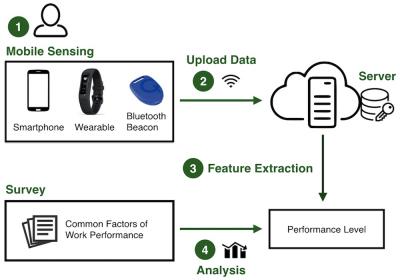Mobile-sensing and consumer tech upgrade the employee review

Credit: Shayan Mirjafari
HANOVER, N.H. – June 24, 2019 -Using smartphones, fitness bracelets and a custom app, researchers have created a mobile-sensing system that judges employee performance.
The system works by monitoring the physical, emotional and behavioral well-being of workers to classify high and low performers.
The new mobile-sensing system opens the way for consumer technology to help employees optimize their performance while also allowing companies to assess how individuals are doing in their jobs. The approach can be both a complement and alternative to traditional performance tools like interviews and self-evaluations.
“This is a radically new approach to evaluating workplace performance using passive sensing data from phones and wearables,” said Andrew Campbell, a professor of computer science at Dartmouth. “Mobile sensing and machine learning might be the key to unlocking the best from every employee.”
In the new system, a smartphone tracks physical activity, location, phone usage and ambient light. A wearable fitness tracker monitors heart functions, sleep, stress, and body measurements like weight and calorie consumption. Location beacons placed in the home and office provide information on time at work and breaks from the desk.
The technology builds on earlier work by Campbell who developed StudentLife, an app that monitors student behavior and predicts academic performance. The sensing system integrates the off-the-shelf tech devices using a newly-designed phone app known as PhoneAgent that is based on StudentLife.
The information is processed by cloud-based machine learning algorithms trained to classify workers by performance level.
“This is the beginning step toward boosting performance through passive sensing and machine learning. The approach opens the way to new forms of feedback to workers to provide week-by-week or quarter-by-quarter guidance on how they are approaching their work,” said Campbell.
To test the system, the team assessed performance of supervisors and non-supervisors in different industries–including high-tech and management consulting–based on a series of self-reported behaviors provided by workers in the study group. Performance was then classified by factors such as the amount of time spent at the workplace, quality of sleep, physical activity and phone activity.
The study shows that higher performers tend to have lower rates of phone usage, experience longer deep sleep periods and are more physically active and mobile. When considering roles, high-performing supervisors are mobile, but visit a smaller number of distinctive places during working hours. High-performing non-supervisors spend more time at work during weekends.
With the ability to provide feedback to both the employee and employer, the mobile-sensing system is meant to unlock the behaviors that drive performance. The passive monitoring technique also offers benefits over traditional review techniques that require manual effort and are seen as burdensome, potentially biased and unreliable.
“Passive sensors, which are the heart of the mobile sensing system used in this research, promise to replace the surveys that have long been the primary source of data to identify key correlates of high and low performers,” said Pino Audia a professor of management and organizations at the Tuck School of Business at Dartmouth.
According to the research team, this is the first time that mobile sensing has been used to classify high and low performance in workers across different industries. In total, the technology was tested on 750 workers across the U.S. for an overall period of one year.
The system was found to distinguish between high performers and low performers with an accuracy of 80 percent.
“The passive monitoring system is meant to be empowering. This approach could certainly benefit companies, but can also be helpful to individual employees who are looking to boost their performance,” said Campbell.
The new technology can produce “a more objective measure of performance offering a better understanding of the workplace environment and the workforce both inside and outside of work,” according to a paper describing the study to be published in the Proceedings of the ACM on Interactive, Mobile Wearable and Ubiquitous Technology.
In the study, continuous monitoring using the consumer technology was combined with traditional questionnaires to categorize performance. The technology is not yet available in app stores, but could be coming to nearby cubicles over the next few years.
The research, supported by the Intelligence Advanced Research Projects Activity (IARPA) within the U.S. Office of the Director of National Intelligence, will be presented at the UbiComp Conference in London in September, 2019.
Researchers at the following institutions all contributed to this study: Dartmouth College; University of Notre Dame; Georgia Institute of Technology; University of Washington; University of Colorado Boulder; University of California, Irvine; The Ohio State University; University of Texas at Austin; Carnegie Mellon University.
###
About Dartmouth
Founded in 1769, Dartmouth is a member of the Ivy League and offers the world’s premier liberal arts education, combining its deep commitment to outstanding undergraduate and graduate teaching with distinguished research and scholarship in the arts and sciences and its leading professional schools: the Geisel School of Medicine, the Guarini School of Graduate and Advanced Studies, Thayer School of Engineering and Tuck School of Business.
Media Contact
David Hirsch
[email protected]



